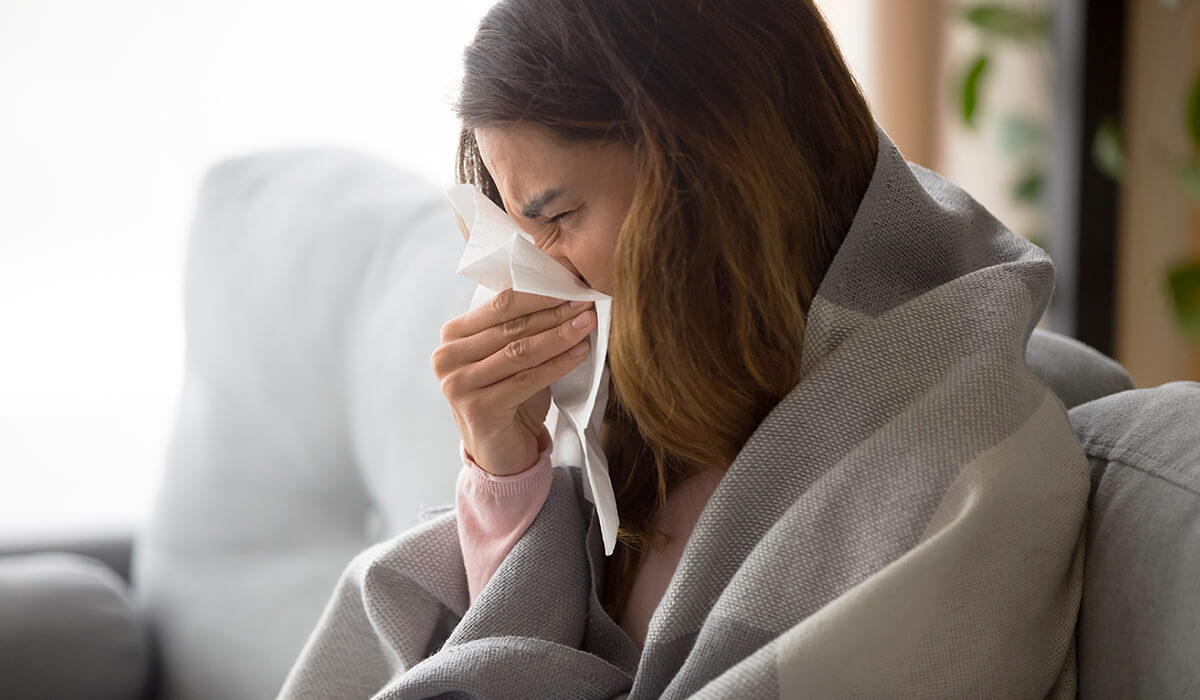Over the last couple of years, respiratory illnesses have been a major topic of conversation. Many people have become hyper-aware of respiratory symptoms, wondering if every little throat tickle or runny nose could be a sign of COVID-19.
But there are several other respiratory illnesses—both acute and chronic—that also affect millions worldwide.
In this blog article, we’ll discuss the different types of respiratory conditions, their symptoms, and the treatments that can provide relief. We’ll also share ways to prevent the spread of contagious illnesses and when you should see a doctor.

Common types of respiratory illnesses
A few of the most common respiratory illnesses include:
- Asthma
- Sinusitis
- Influenza
- COVID-19
- Common cold
- Bronchitis
- Chronic Obstructive Pulmonary Disease (COPD)
- Chronic bronchitis
- Emphysema
- Lung Cancer
- Cystic fibrosis
- Pneumonia
- Pleural effusion
- Pneumothorax
Chronic respiratory diseases
Chronic respiratory diseases (CRDs) are diseases of the airways and other structures of the lung. According to the World Health Organization, over 3 million deaths are caused by CRDs every year.
Some of the most common CRDs include:
- Asthma
- Chronic obstructive pulmonary disease (COPD)
- Occupational lung diseases
- Pulmonary hypertension
Risk factors for many CRDs include smoking, air pollution, exposure to chemicals or dust at work, and frequent lower respiratory infections during childhood. More than 25 million people in the United States have asthma, and nearly 15 million adults have been diagnosed with COPD.
While CRDs are not curable, some treatments help dilate air passages and improve symptoms like shortness of breath.

Respiratory infections
Respiratory infections occur when a virus or bacteria enters your respiratory system through contact with someone else who is sick. This is why healthcare professionals recommend wearing masks and frequent hand washing to prevent the spread of respiratory illnesses, such as COVID-19 and the flu.
Your respiratory system is the part of your body responsible for breathing. So respiratory infections can affect your sinuses, throat, lungs, or airways.
Upper respiratory versus lower respiratory illnesses
There are two types of respiratory infections: upper respiratory and lower respiratory infections. The difference between lower respiratory infections and upper respiratory infections is the location of the infection and its symptoms.
Upper respiratory infections are mainly caused by viruses and affect your sinuses and throat, while lower respiratory infections affect your airways and lungs. Lower respiratory infections tend to last longer and are more serious.
Symptoms of upper respiratory infections include:
- Sneezing
- Runny nose
- Sore throat
- Cough
- Sinus pressure
- Hoarse voice
- Swollen lymph nodes
- Fatigue
Lower respiratory illnesses are more common during the colder months and include bronchitis, bronchiolitis, and pneumonia. These conditions (especially pneumonia) can be severe or even fatal.
Common symptoms of lower respiratory infections can range from mild to severe and include:
- Cough (with or without mucus)
- Fever
- Fatigue
- Shortness of breath
- Chest pain
With a condition like bronchitis, you can often treat symptoms at home. However, if you are older, have a weakened immune system, or have an underlying health condition (like asthma or COPD), you may be at higher risk of severe illness and might require hospitalization.

How are acute upper respiratory infections treated?
For most people, upper respiratory illnesses, like the common cold, typically last a week or two and go away on their own.
You can ease the symptoms of an upper respiratory infection at home with remedies including:
- Rest
- Fluids
- Over-the-counter pain relievers
- Over-the-counter cold medicines
If your symptoms are severe or last longer than two weeks, see a doctor. You will likely need antibiotics if you have a bacterial infection, like strep throat.
How are lower respiratory infections treated?
Lower respiratory illnesses like bronchitis will typically go away on their own in one to three weeks for most healthy people. For bronchitis caused by the flu virus, your doctor may prescribe an antiviral medication called Tamiflu.
Treatment for pneumonia depends on its type. Doctors treat pneumonia caused by bacteria with antibiotics. Viral pneumonia, however, doesn’t require any specific medication, only supportive care to ease symptoms.
To relieve the symptoms of lower respiratory infections, your doctor may recommend:
- Over-the-counter decongestants (guaifenesin)
- Albuterol inhalers
- Oral steroids (prednisone)
Ways to prevent respiratory illnesses
Respiratory illnesses are common, but there are things you can do to reduce your risk of catching or developing one, including:
- Wash hands frequently with soap and water
- Avoid physical contact with sick people
- Wear a mask when needed
- Stop smoking
- Avoid places with lots of dust or chemicals
- Maintain a healthy weight
- Eat a balanced diet
- Get enough sleep
Get the care you need at Logansport Memorial Hospital
If you’re struggling because you have one of the many common respiratory illnesses, the pulmonary experts at Logansport Memorial Hospital are here to help and see you through to recovery.
To make an appointment with our board-certified pulmonologist, Dr. Abhishek Vedavalli, call the LMPN Pulmonology office at (574) 753-5640 or request an appointment online.
You might also like:




